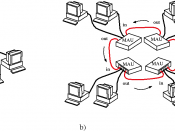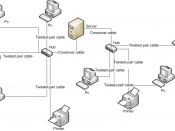Differences of NTC360 Terms � PAGE �1�
Differences of NTC360 Terms
Introduction
The classification of topologies plays a huge role in the transmission of data. The topologies that I will discuss are Mesh, Bus, Ring, and Star. Moreover, the discussion will also include information on the differences of Ethernet, Token Ring, FIDDI, and wireless networks. Within the discussion of the topologies will be the advantages and disadvantages of each type discussed. Furthermore, I will discuss the levels of the OSI Model and TCP/IP functions.
Mesh
Mesh topology is a way to route data, voice, and instructions between nodes. In addition, mesh topology the most secure of all topologies because whether the links are broken or blocked, the connections will jump from node to node until the end has been reached. The main advantage of mesh topology would be if a cable somewhere on the network is broken, the network will not completely fail.
The disadvantage of the mesh topology would be the expense of the extra cabling requiring as opposed to the other topologies.
Bus
A bus topology consists of a server at one end and the client PCs that connect with distinctive areas of the network. The streaming data that are being sent down the network passes through each computer. The advantages of the bus topology would be that it is inexpensive and easy to implement and extend. On the other hand, a disadvantage of using bus topology would be that it is not easy to administer or trouble shoot because there is no central point from which all PCs connect on an equal basis. Moreover, while coping with high rates of data transmission from one PC to another, it cannot cope as well when data transmits from several machines at the same time. Furthermore, the bus topology requires...


